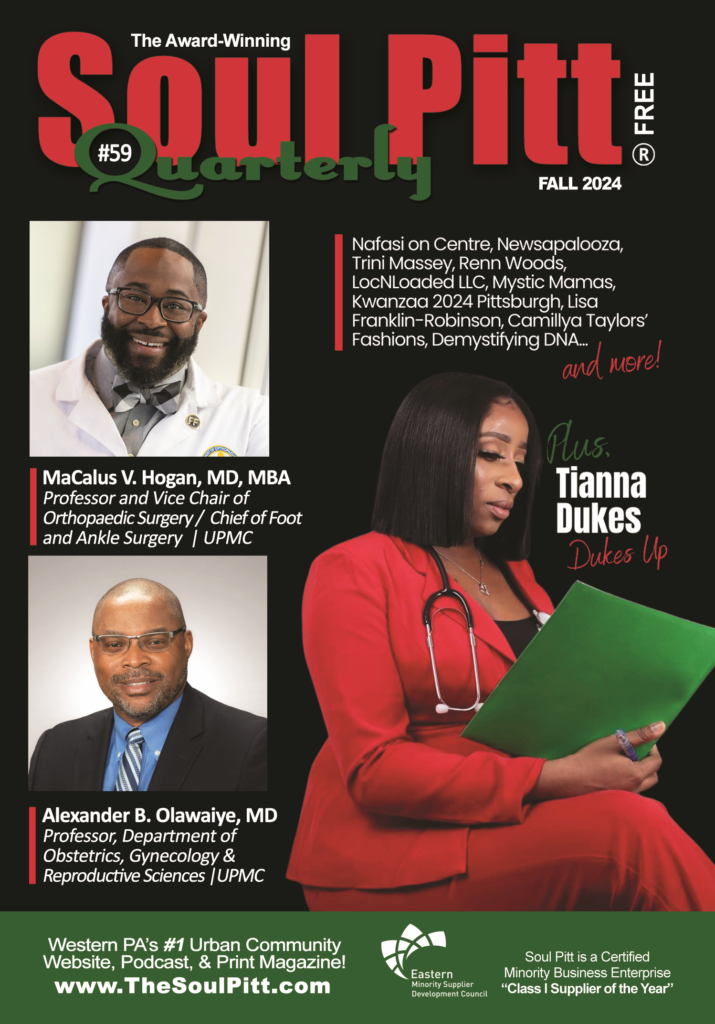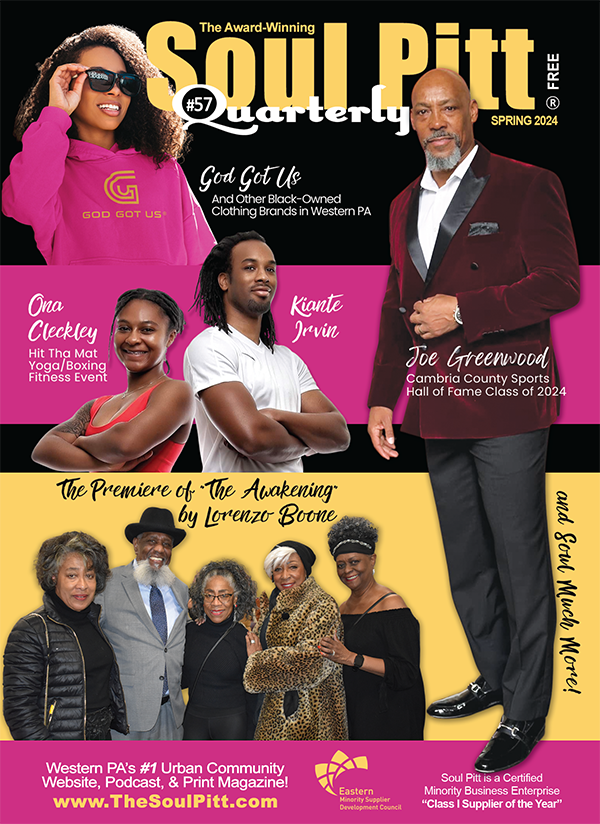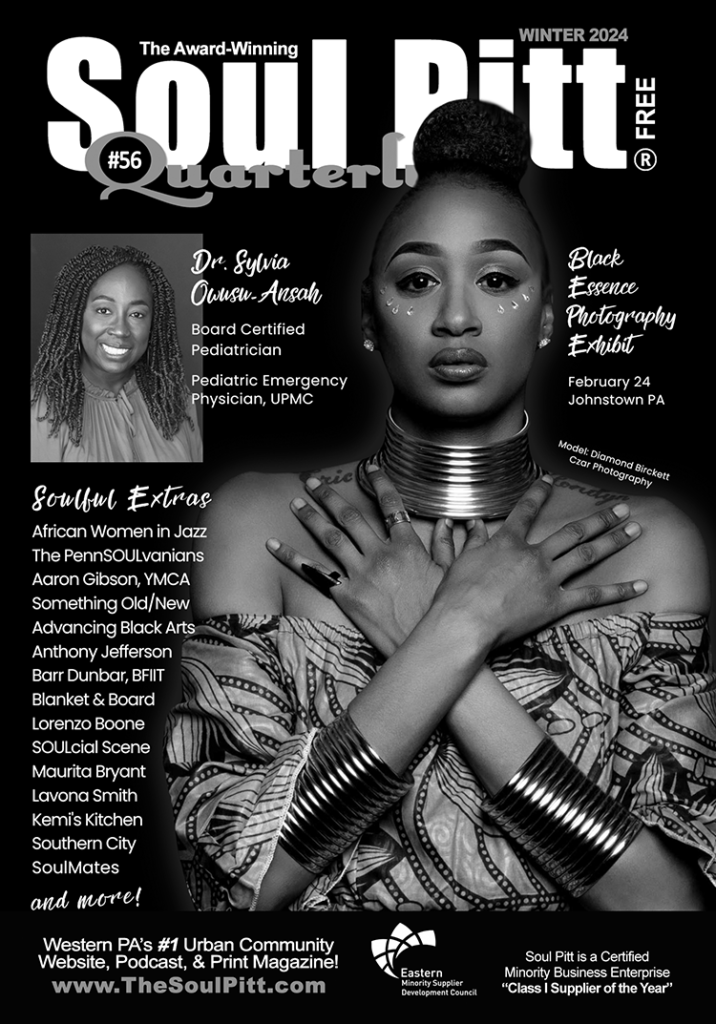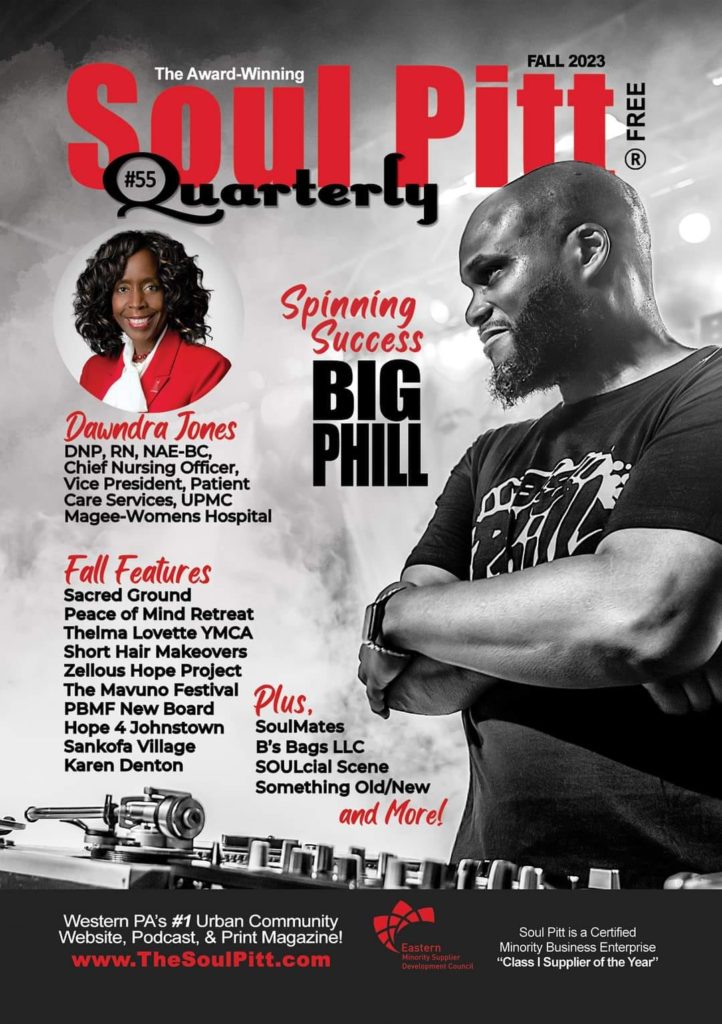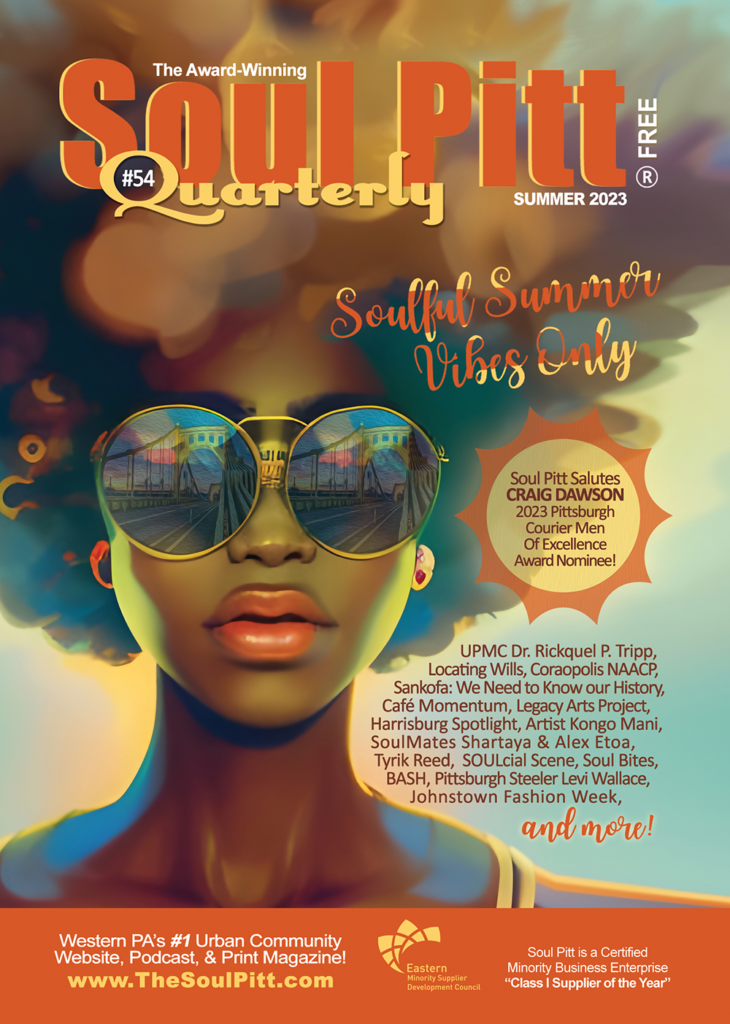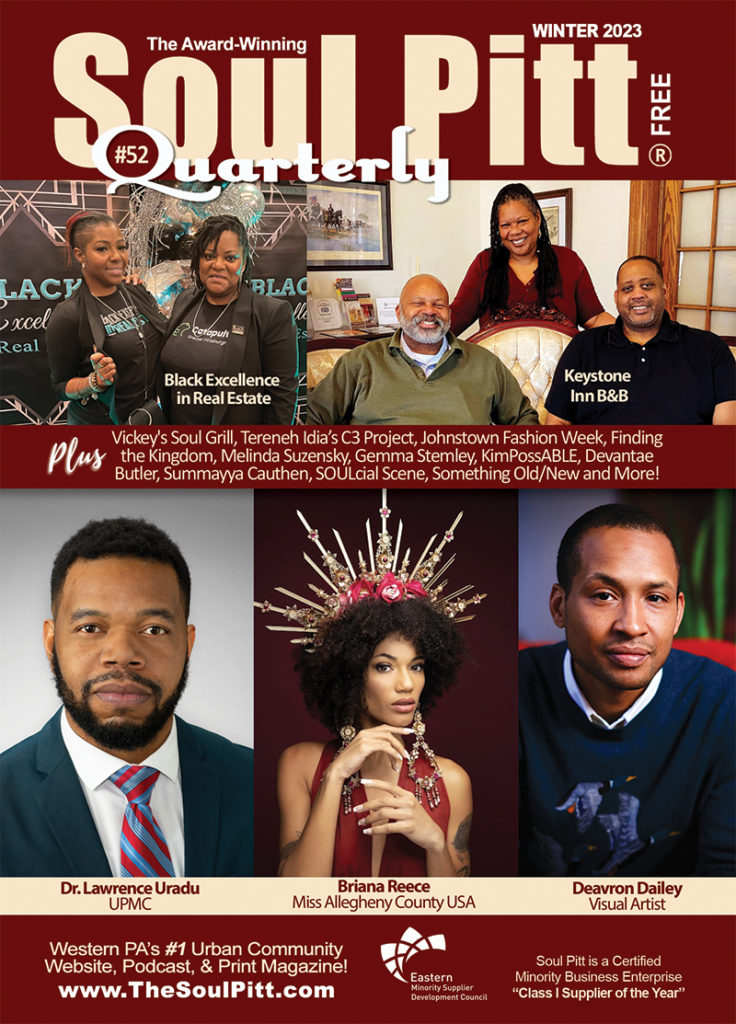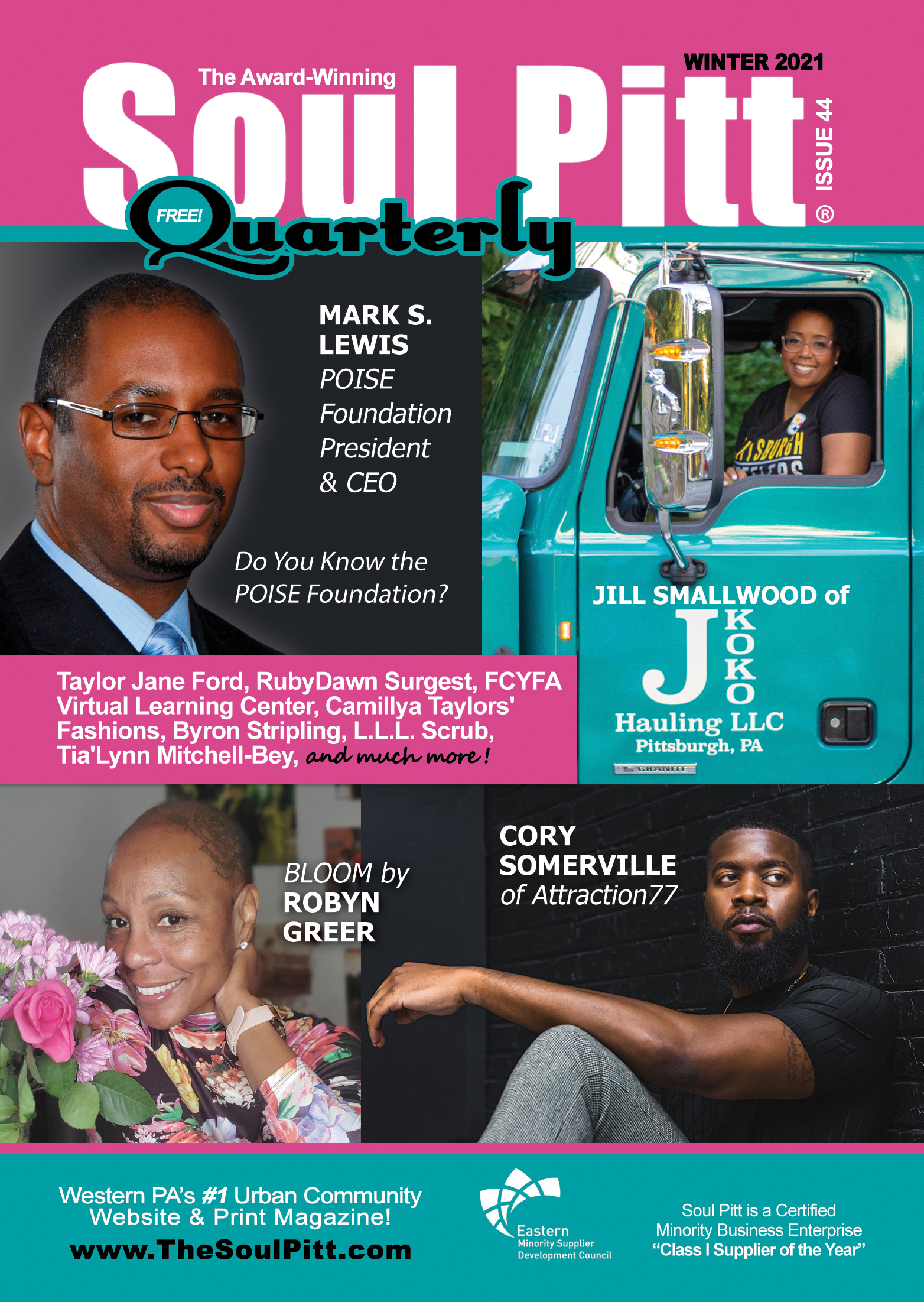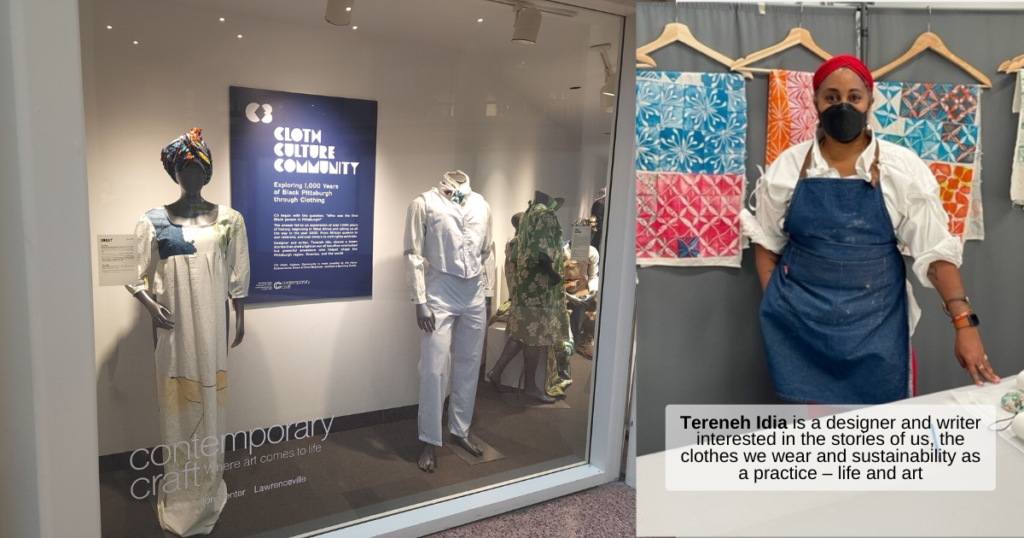
SPQ had the honor to visit Tereneh Idia in her workshop at the Contemporary Craft Center in Lawrenceville a few weeks before the opening of her exhibit C3: Cloth, Culture, Community, Exploring 1,000 years of Black Pittsburgh through clothing. The Contemporary Craft gallery at BNY Mellon – Steel Plaza T station hosts the finished Exhibit through April 16, 2023. (Grant Street, downtown Pittsburgh).
On a warm, sunny late fall afternoon, I visited Tereneh’s workspace. Fabric, metal accessories, historical documents, and photos that inspired her designs filled her space.
I asked Tereneh about the C3 project’s goals. “I wanted to tell the story of Black Pittsburgh in a way that showcases different points of history and people we don’t hear enough of,” she said.
The exhibit takes viewers from pre-enslavement Africa to the US and Pittsburgh area and the great migration. But the Exhibit does not stop there; it moves into a futuristic state with Amina 3000.
“I start with Queen Amina, in the 1400s/1500s in the Hausa land (now Northern Nigeria). Queen Amina was a fantastic warrior who loved armor, weapons, and horses. She was a general and fierce commander. The first time I saw her was on a Nigerian postage stamp. People said she was a badddd woman. The Hausa people were known for their metal smithing and ironwork.
C3 Exhibit begins with Queen Amina (Africa) and ends with the futuristic Amina 3000 (Pittsburgh). To create the timeline and design the clothing for the Exhibit Tereneh dove deep into historic exploration and research. Initially, she started the project to figure out who was the first Black person in Pittsburgh, as Blacks were here before this was a city.
She added, “I wanted to start this project before enslavement because the conversation around Blacks focuses on the Transatlantic Slave Trade. I wanted to start in Africa.” Her research included trips to the Heinz History Archives, online resources, the Carnegie Library of Pittsburgh, and historical documents found in non-circulation.
“We go from Queen Amina in Africa to the flying Africans depicting the idea that we can fly. Also, there were enslaved Blacks in Pittsburgh. One person found in the Allegheny County Records was “Suck,” a Negro enslaved woman who lived near present-day Wilkinsburg in the late 1700s. Her name on record is Suck, probably in error for Sukey. A 1790 document recorded that the enslaved Negro Sukey of her own free will placed her daughter into indentured servitude to a man named McKee, who was the founder of McKeesport,” Tereneh said.
The artist struggled with this knowledge and then realized being born into enslavement, the mother placing her daughter into indentured servitude was the closest she could get to freeing her daughter in their surrounding circumstances. This Exhibit segment shows that enslavement was part of Pittsburgh’s history.
Next, Tereneh found two Black soldiers, Louis Cook, who served on the French side of the French and Indian War. Cook’s father was African, and his mother was Mohawk, raised as a Mohawk warrior. Cook was there at Braddock’s defeat.
The second was John B. Vashon, an activist, abolitionist, and entrepreneur who served in the Navy in the War of 1812. He was a wealthy man who owned bathhouses downtown (Pittsburgh); because of his wealth, he was active in abolition and the underground railroad. In addition, she discovered that two Black men in the 1800s signed the document that created Allegheny County. Through her research, Tereneh feels there were more Black businesses in 1800 than there are now. Our lost history.
The Exhibit moves to the Great Migration North with the quilter’s story of a family forced to leave the south because of a white woman’s physical harassment of her husband. The wife and daughters made their way safely to Pittsburgh. The mother wears an enamel brooch with a cameo of her husband and the route north to Pittsburgh. Tereneh took an enamel workshop to be able to create this brooch. When the family flees the south, they have no winter coat and wear the quilt to keep them warm in their travels. Later you will see that Amina 3000 is also wearing this brooch. It’s incredible how the futuristic Amina 3000 found the brooch from the 1800s and used it as part of her armor.
Tereneh used her grandfather, Thaddeus Mosley, Sr., as inspiration for the coalminer in the industrial era. The Pittsburgh region is known for its steel industry, but people are unaware of the Black coal miners. This way, people would be aware of this history and research to know more. She worked with the Rivers of Steel Arts, who loaned her the mining helmet and steel-toed boots. The carbide lantern belongs to her Dad, which belonged to his Dad. Tereneh mentioned that if you want to hear exciting stories about her grandfather and his time in the mines since he was a teen and his dangerous role in organizing the union, ask her Dad.
Included in the Zoot Suit exhibit, the watch chain has a triple V for victory to include the history of the ‘Blue’ Discharge. The Blue Discharge given disproportionately during WWII to African Americans and LGBTQ service members. It is not an honorable or dishonorable discharge. Still, service members were subjected to civilian life discrimination, denied military benefits, and had difficulty finding work because of the negative connotations of a Blue discharge.
The Exhibit includes a timeline of Black entrepreneurs, the Great Migration, the Black Arts Movement, and Hip Hop with a black and yellow tee paying homage to Pittsburgh native Wiz Khalifa and the legacy of Pittsburgh’s contribution to hip hop. The Exhibit ends with or starts again with the futuristic Amina 3000.
On the wall of her workspace hung the finished Pittsburgh African Flag. Tereneh describes the flag as one that honors Black Pittsburgh. Elements used in the flag gathered from West Africa and North America. These gold dots show the different ports, and the lines between depict the movement of the enslaved Hausa first coming to Pittsburgh (not saying this specific group of Africans did come to Pittsburgh). The Eagle symbolizes a mythical creature in Nigeria and America. The floral plants of Africa, southwestern Pennsylvania, garlic, fig, dandelions, and ferns represent people who escaped from the south; they looked for the fern as a sign of fresh water. “Every outfit will have an element of the flag in it,” Tereneh said.
Not only did Tereneh learn enamel and metalwork to create her designs, but she also learned how to block print, which came over from African textile work, and fabric weaving. Additionally, resources used in her Exhibit came from upcycled fabrics, found pieces, creation of new fabrics by blocking, printing, and blending fabrics.
She adds, “I would like to mention and thank @creative_reuse! While the main sustainable fabric (hemp and organic cotton) used in C3 was from a company in California, all the other fabric used was from Creative Reuse, including the fabulous seersucker fabric worn by Mr. Vashon. Thanks to @eonsfashion for the vintage cufflinks.”
The focal image of this Exhibit is Amina, from Queen Amina of the continent of Africa to the futuristic Amina 3000. Tereneh’s research on Queen Amina included a graphic novel Wake by Rebecca Hall, an exhilarating tale of Black women’s leadership roles in slave revolts. She shared, “I read that the more women onboard the slave ships, the more likely a revolt would happen.” The C3 Exhibit is on a mission to include Blacks in Pittsburgh’s history and stop the selective and narrow view of Pittsburgh’s history only from the white lens.
Amina 3000 adds to the futuristic narrative of the area (there are Black people in the future). Tereneh envisions the future as the land of Pittsburgh goes back to the Seneca. The Seneca creates a multi-cultural government, and Amina 3000 is part of the Council. Because of the climate crisis, it is hot, the topography has changed, and there are problems with the water. The Seneca’s seat of Council is located in the Hill District, which has been renamed August (for August Wilson).
Here we are at the end (or at a futuristic beginning) of the statue of Amina 3000 with her chain-link breastplate, shoulder holster, crown, forging knife, and the flag as her coat. Dried herbs represent her undergarments, and in the background, her portrait was painted by the artist’s brother, Arnie Mosley. As well as Tereneh says she will publish a publication to accompany the Exhibit allowing her to use her writing skills to share these stories.
To be in this workspace and see the fabrics yet to be sewed, to see the accessories that have yet to be connected to an outfit, to look at the post-it filled timeline board, to be privy to this artist’s creative operation of methods, to be at the table with it all spread out before me, to see it in its infancy was a good opportunity.
The last question I asked Tereneh if the Exhibit had theme music, and she said, “A Love Supreme” by John Coltrane, as I created this project out of my love for being Black and love for Black Pittsburgh.”
This article was first published in Soul Pitt Quarterly Print Magazine (Winter 2023). Copyright Soul Pitt Media. All Rights Reserved.


